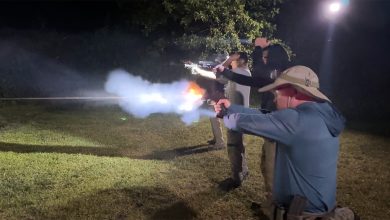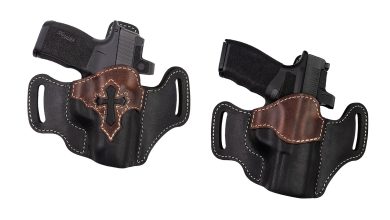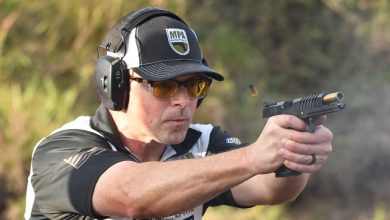Ocular Dominance

Ocular dominance, more commonly referred to as eye dominance, is an essential factor in achieving accuracy and consistency for anyone stepping into the shooting world. Much like the dominant hand, the dominant eye plays a significant role in aiming and aligning a firearm. However, for some, nuances like cross-eye dominance, dual eye dominance and central eye dominance can present unique challenges.
Eye dominance refers to the preference of one eye over the other when focusing on objects. This dominant eye provides more accurate spatial reference information, which the brain prioritizes for tasks that require precision. While the dominant eye is not always the one with better vision, it is the eye that the brain relies on more for visual input. In shooting, the dominant eye is used for sights alignment or verification.
Cross-eye dominance occurs when an individual’s dominant eye is opposite their dominant hand—for instance, a right-handed person with a left dominant eye. While this phenomenon is relatively common, it can complicate shooting techniques.
Aiming issues arise when the alignment of the firearm naturally favors the dominant hand, while the dominant eye attempts to direct the line of sight. Shooters may unconsciously tilt their head or body to bring their dominant eye into alignment, potentially leading to poor shooting form and discomfort. Without addressing cross-dominance, achieving consistent accuracy can be difficult.
Addressing cross-eye dominance often involves strategic adaptation. Some shooters may choose to switch hands entirely, aligning the firearm with their dominant eye. Although this can feel unnatural at first, dedicated practice often yields significant improvement in accuracy. Another common approach is training the non-dominant eye through deliberate obscuration of the dominant eye. Using an eye patch, tape or specialized shooting glasses during practice can help rewire the brain to favor the non-dominant eye during critical moments.
For those unwilling or unable to switch hands or train the non-dominant eye, adjusting head positioning can offer a practical solution. By slightly tilting the head or shifting the firearm’s alignment across the body, shooters can bring their dominant eye into play without major alterations to their natural shooting stance. Additionally, both-eyes-open shooting techniques allow the dominant eye to lead while the non-dominant eye contributes peripheral awareness, a method particularly useful in dynamic or tactical shooting scenarios.
Dual eye dominance, or alternating eye dominance, occurs when neither eye consistently takes precedence. In this case, the brain may switch between eyes depending on the task, lighting, or other factors. While relatively uncommon, dual dominance can pose significant challenges for shooting. Unpredictable sight alignment results from switching between eyes, leading to inconsistent targeting. The shooter may struggle to determine which eye to rely on, particularly in dynamic or high-pressure situations.
Adapting to dual eye dominance begins with observation and awareness. Shooters must identify patterns in their dominance shifts, such as whether changes occur under specific lighting conditions or during certain types of aiming tasks. Developing consistency through repetition and dominance stabilization techniques, such as blurring one eye’s vision during practice, can help mitigate the challenges of dual dominance. For some, using advanced optical aids, like holographic or red dot sights, provides the necessary flexibility to maintain accuracy despite fluctuating dominance.
In rare cases, some shooters exhibit central eye dominance, where both eyes contribute equally to visual input. While this might sound advantageous, it can complicate tasks requiring precision alignment, as the brain may struggle to prioritize one eye over the other for specific targeting tasks.
For handgun shooters, the compactness of the firearm allows for greater flexibility in positioning. Cross-eye dominant shooters often find it effective to tilt their head slightly or shift the handgun across their body to align with the dominant eye.
Rifle and shotgun shooters face unique challenges due to the long-barreled design of these firearms. Switching shoulders is often the most effective solution for cross-eye dominant shooters, enabling the dominant eye to align naturally with the sights. While this adjustment requires significant practice, it ensures the best possible alignment for precision shooting. For those unable to switch shoulders, optical aids such as red dot sights, holographic sights, and scopes with adjustable eye relief offer an alternative path to success.
Understanding your ocular dominance not only improves technical skills but also enhances shooting by reducing frustration and increasing confidence in your abilities. For novice shooters, starting with an understanding of eye dominance helps set a strong foundation for success.
Over time, changes in vision or habits can affect dominance patterns, making periodic reassessment essential. Shooters who remain adaptable and open to refining their techniques based on their eye dominance often achieve the greatest success.
Beyond personal shooting pursuits, understanding ocular dominance also plays a crucial role in training others. Firearm instructors must account for their students’ eye dominance to provide effective guidance and appropriately tailored instruction. By recognizing and addressing dominance-related challenges early, instructors can help students develop proper habits and avoid frustration.
The connection between ocular dominance and shooting highlights the interplay between human biology and skill development. By identifying your dominant eye and tailoring your shooting technique accordingly, you can enhance your performance. As with any skill, practice and experimentation are the keys to finding what works best for you.
Read the full article here



![5 Guns You Should NEVER Sell in 2025 [You’ll Regret It Later] 5 Guns You Should NEVER Sell in 2025 [You’ll Regret It Later]](https://tacticalgunstores.com/wp-content/uploads/2025/04/1745048130_maxresdefault-390x220.jpg)



